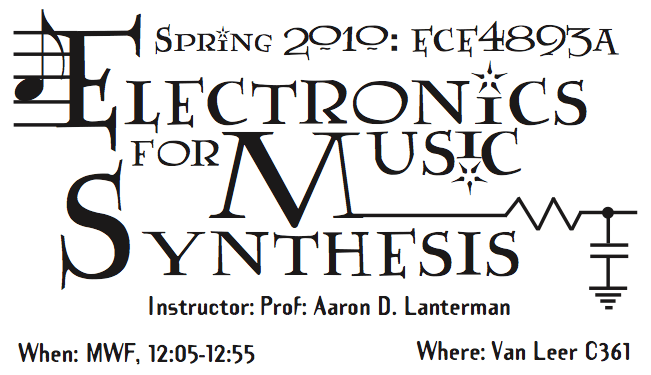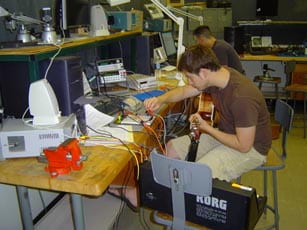ECE4893A: Electronics for Music Synthesis (Spring 2010)


Office: Centergy 5212 (but I’m almost never there)
Phone: 404-385-2548 (but I almost never answer it)
E-mail:
lanterma@ece.gatech.edu (by far
the best way to reach me; please include “EMS” somewhere in the subject of class-related
e-mail so I can find it quickly)
Course website:
users.ece.gatech.edu/~lanterma/ems10
Prerequisites: ECE3040 and ECE3041 (with concurrency allowed,
i.e. you can
be taking ECE3041 this semester and be OK). Basically, I need some
familiarity with op amps, diodes, and transistors, and I need to make sure that
you have had some experience using a scope by
the time you will to use one in EMS. (Oscilloscopes are
introduced pretty early in ECE3041, which is
what makes the “concurrency” part OK)
Website for previous offering:
EMS (Spring 2008) –
will help give you a feel for what the class is like
The photo: Chris Garyet testing his voltage-contolled “wah” circuit
(from Spring 2006)
(Note: I often abbreviate the class title as “EMS.” This usage of “EMS”
should not be confused with
“EMS” as in Electronic Music
Studios, the makers of many classic synthesizers such as the Synthis.)
Grading:
Grades will be based on a series of written homeworks and possibly a few
simple
lab assignments, an in-class quiz given about 2/3 of the way through the
semester that
will be weighted the same as a homework, and the quality of a final project in
which you will design and build a module for a modular synthesizer.
I consider the project to be the most important thing in the class;
hence, your course grade will max out at whatever your project grade is,
e.g., if you do B work on the homeworks, etc., but turn in an A project,
you might get an A for the class, or you might get a B;
but if you do A work on everything else but turn in B level project,
your grade won’t be an A.
Aaron’s SDIY Pages
- Synth
DIY Datasheet and Ap Note Collection - Music synthesis
patents collection, with some brief commentary - Current
modular synth manufacturers – look through these to get ideas for your
own new designs, ideas for packaging, etc.
Homeworks
- Homework 1 (due Friday, Feb. 12 at the
start of class) - Homework 2 (due Friday, Feb. 26 at the
start of class) - Homework 3 (due Friday, April 2 at the
start of class) - Homework 4 (due Monday, April 19 at the
start of class)<!– - Homework 2 (due Tues, Feb. 28)
- Homework 3 (due Thurs, March 13)
- Homework 4 (due Tues, April 8)
–>
Lectures
Dear readers from outside the class:
If you find these
lectures useful, please consider making a small donation (maybe $25 or
thereabouts, although any amount is appreciated)
to the Georgia Tech Foundation earmarked to go towards
my synthesizer research; the funds will go towards parts and equipment
for student projects.
Here
are instructions on how to donate.
Since this is a lecture/lab class, I will only lecture for 2/3 of the class
periods, and that lecturing will be “front loaded,” i.e. I will lecture for
the first 2/3 of the class, and the last 1/3 of the class you will be just
working on your final projects, with me dropping by the lab to help out as
much as I can.
If you look at the lectures from the
Spring 2008 version
of
the course, you will get a pretty good idea of what we will cover in the
future.
- 1/11, Session 1: 40 Years of Music Synthesis (Part 1)
(video) - 1/13, Session 2: 40 Years of Music Synthesis (Part 2)
(video) - 1/15, Session 3: Demo of a Modular Synthesizer
(video) - 1/18: No class (MLK Holiday)
- 1/20: “Day of Engagement”
- 1/22, Session 4: Circuit theory review, part 1
(video) - 1/25, Session 5: Circuit theory review, part 2
(video) - 1/27, Session 6: Circuit theory review, part 3
(sorry, camera ate video file – here are links to lectures from previous
versions of the class covering similar material:
Spring 2006, RealMedia:
Part 1,
Part 2;
Spring 2008: Part 1,
Part 2) - 1/29: No class (Aaron going to
GTREET workshop) - 2/1, Session 7: Operational Transconductance Amplifiers, Part 1
(sorry, camera ate video file – here are
links to lectures from previous versions of the class covering similar
material: Spring 2006, RealMedia;
Spring 2008) - 2/3, Session 8: Operational Transconductance Amplifiers, Part 2; Linear
Current Sources
(video) - 2/5, Session 9: Voltage Controlled Oscillators – Sawtooth Cores
(sorry, camera ate video file – here are links to lectures from previous
versions of the class covering similar material:
Spring 2006,
RealMedia;
Spring 2008) - 2/10, Session 10: Exponential Current Sources, Part 1
(Spring 2010 video only shows half
of board, so here is a link to a lecture from a previous version of the class
covering similar material:
Spring 2008) - 2/12, Session 11: Exponential Current Sources, Part 2
(video)
A tutorial on exponential convertors and temperature compensation, by
Rene Schmitz (this is the description my lecture was based on)- Tempo
Equations, by Ian Fritz (a much more detailed analysis)
- 2/15, Session 12: Voltage Controlled Oscillators – Triangle Cores
(video)- Buchla 259
Vintage Modular Oscillator youtube demo - Buchla
259 schematics,
on 4 pages:
1,
2,
3,
4. In class, we looked at the triangle core of the “Principal
Oscillator,” is in the upper right corner of page 2. - The
Buchla
258 is an older, simpler oscillator with a similar
triangle core: 258C,
258A,
Mark Verbos’
258 variant. (Mark
keeps an excellent Buchla
Tech blog.) - The new Buchla 261e
is quite similar to the Buchla 259. Here’s a
youtube demo of the 261e:
Simple 261e Melody - Buchla 259
vs. 261e Audio Comparisons on electro-music - At the start of lecture, I mentioned
Alessandro
Cortini,
who used to play synths for Nine Inch Nails, and who sold
his
Buchla 259 a while back. Alessandro has been making music on his
Buchla 200e system
under the name
blindoldfreak. Here’s the
EAR system
I referred to. - I had no idea people electrocuting themselves while trying to steal
copper wire was such a common occurrence. Google “copper wire electrocuted”
without the quotes and you’ll see what I mean.
- Buchla 259
- 2/17, Session 13: Simple Waveshaping Circuits, part 1
(video)- Related to circuits shown in class:
- R. Williams,
Triangle to Sine Conversion with OTAs - M.H. Miller,
Triangle
to Sine Conversion (Nonlinear
Function Fitting), ECE414 Notes - R.G. Meyer, W.M.C. Sansen, S. Lui, S. Peeters,
The Differential Pair as a Triangle-Sine Wave Converter,
IEEE J. of
Solid-State Circuits, June 1976, pp. 418-420. - G. Klein,
Accurate Triangle-Sine Converter,
IEEE International Solid-State Circuits Conference, Digest of Technical
Papers, Volume X, Feb. 1967, pp. 120-121.
- R. Williams,
- Other ideas:
- H. Hassan,
FET
Differential Amplifier as a Tri-Wave to Sine Converter,
Proc. 36th Southeastern Symposium on System Theory, 2004, pp. 427-430 - Z. Tang, O. Ishizuka, H. Matsumoto,
MOS Triangle-to-Sine Wave Convertor Based on
Subthreshold Operation, Electronics Letters,
Vo. 26, No. 23, Nov. 8, 1990, pp. 1983-1985.
- H. Hassan,
- Related to circuits shown in class:
- 2/19, Session 14: Simple Waveshaping Circuits, part 2
(video) - 2/22, Session 15: Complex Waveshaping Circuits, part 1
(video) - 3/1, Session 16: Complex Waveshaping Circuits, part 2
(video) - 3/3, Distribution of the Blacet kits
- 3/17, Session 17: Single-pole OTA-C lowpass filters
(video)- Oberheim/Rossum patent,
Circuit for Dynamic Control of Phase Shift - ARP patent,
Frequency
Sensitive Circuit Employing Variable Transconductance
Circuit
- Oberheim/Rossum patent,
- 3/19, Session 18: 4-pole filters with feedback
(video)- Note that most of the linear analysis on the Moog ladder filter, as
presented in papers and webpages listed under Session 22, applies to
4-pole-with-feedback filters built with OTA-C sections. (An
analysis of the nonlinearities would show differences.)
N-Pole Filter Circuit Having Cascaded Filter Sections – careful,
the resonance feedback path drawn on the first page is in error! It should
be going to the negative terminal of the first OTA on the left.
- Note that most of the linear analysis on the Moog ladder filter, as
- Pre-recorded, Session 19A: Single-pole OTA-C highpass filters
(video) - Pre-recorded, Session 19B: Examples of four-pole OTA-C filters
(video) - 3/29, Session 20: Transistor & diode ladder filters
(video)- Moog patent,
Electronic High-Pass and Low-Pass Filters Employing the Bass to Emitter Diode Resistance of Bipolar Transistors - T. Stilson and J. O. Smith,
Analyzing
the Moog VCF with
Considerations for Digital Implementation,
Proceedings of the 1996
International Computer Music Conference, pp. 398-401. - A. Huovilainen,
Non-Linear
Digital Implementation of the Moog Ladder Filter, Proc. of the
7th Int. Conf. on Digital Audio Effects (DAFx’04), Naples, Italy, Oct. 5-8,
2004. - T.E. Stinchcombe,
Analysis of the Moog Transistor Ladder and Derivative Filters,
Oct. 25, 2008 - M. Civolani and F. Fontana,
A Nonlinear Digital Model of the EMS VCS3 Voltage-Controlled Filter,
Proc. of the 11th Int. Conf. on Digital Audio Effects (DAFx’08), Espoo,
Finland, Sept. 1-4, 2008. - T.E. Stinchcombe’s page on
Diode
Ladder Filters - T.E. Stinchcombe’s
Filter pole animations
- Moog patent,
- 3/31, Session 21:
Second-order filter properties; system view of first-order filters
(video)- T.E. Stinchcombe’s
Filter
pole
animations (see the bottom of the page for second-order examples)
- T.E. Stinchcombe’s
- 4/2, Session 22: State variable filters
(video)- MIT 2.161 Signal Processing notes,
Op-Amp Implementation of Analog Filters (see Section 2) - R. Johnson,
Programmable
State-Variable Filter Design For a
Feedback Systems Web-Based Laboratory - Daycounter, Inc. Engineering Services,
State
Variable Filter Design Equations
- MIT 2.161 Signal Processing notes,
- 4/5, Session 23: Sallen-Key filters, part 1
(video) - 4/7, Session 24: Sallen-Key filters, part 2
(video)- Demo:
Adaptation of the lowpass gate
circuit from the Buchla Music Easel - Demo: Thomas White’s
Buchla
Lopass Gate 292 Clone - T.E. Stinchcombe’s page on
The
Korg35 Chip, the MS-10 & MS-20 Filters, Clones and Links - T.E. Stinchcombe,
A Study of the Korg MS10 & MS20 Filters, August 30, 2006
- Demo:
- 4/18: Session 25: Survey of digital music synthesis; wrap-up
(video)
References
We will draw material from numerous sources: book, articles, patents,
and particularly schematics and descriptions posted on websites. Think of
google as the main class text. Here’s some
good ones:
- Hal Chamberlin, Musical Applications of Microprocessors, 2nd
Edition, Hayden, 1982; if you
get just one book, this is THE book to get. Although it has
“microprocessors” in the title, it has a superb section on analog circuits.
NOS (New Old Stock – meaning old, but unused) copies are available for
purchase from Jeff Dec ($50 + shipping); e-mail
jdec@mindspring.com - Barry Klein, Electronic Music Circuits, SAM, 1982. Long out
of print, but photocopies can be purchased directly from
barry.l.klein@wdc.com - V. Valimaki and A. Huovilainen,
Oscillator and Filter Algorithms for Virtual
Analog Synthesis, Computer Music Journal, Vol. 30, No. 2, 2006,
pp. 19-31. - T. Stilson,
Efficiently-Variable Non-Oversampled Algorithms in Virtual-Analog
Music Synthesis, PhD Thesis, Standford University, June 2006.